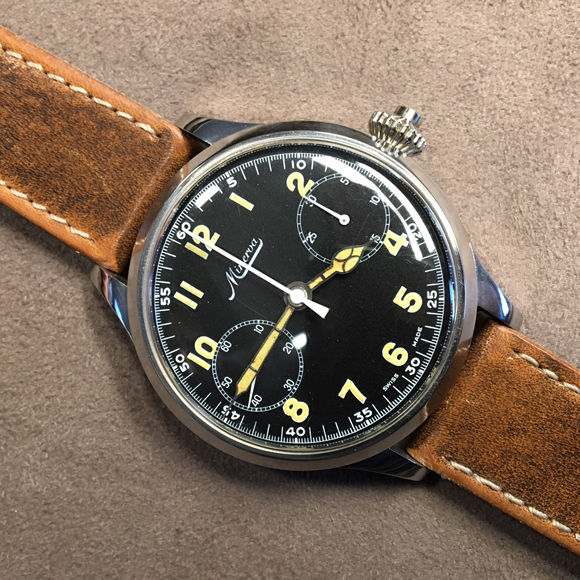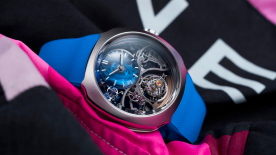What have your priorities been, since you arrived in December 2015?
Our product is at the heart of everything, and that’s what I focused my attention on when I began working with Jérôme Lambert, the CEO of Montblanc. We immediately concurred that the brand’s watch selection didn’t include any professional sports watches, and that this sector represented the greatest potential for development. Particularly since the purchase of Minerva has given Montblanc an unrivalled source of legitimacy in this area, and it’s the sector in which I have built my entire career. We therefore put in place quite a substantial programme, with a view to revealing the new range to the public at the SIHH in January 2017. This new strategic approach perfectly complements the “share your passion for watchmaking” strategy initiated by Jérôme Lambert, which has succeeded in offering original watchmaking content at a price that defies all competition, while at the same time bringing the extremely high-end traditional complications produced in Villeret (where the Minerva plant is based) into Montblanc’s ambit. While Montblanc has only 20 years’ experience in watchmaking (and we’ll be celebrating that next year), it can nevertheless count on Minerva’s amazing heritage. The creation of a centre of excellence and development for watch movements, which incorporates all this accumulated heritage and expertise, has enabled us to translate it into a more accessible language. This also meant setting up a major new operational arm. In parallel with that, we also had to integrate Minerva into the Montblanc galaxy. My appointment coincided with the creation of a watch division. So, my second priority was to reorganise our watchmaking activities within the new entity I was now running, and bring all product development and marketing activities back to Le Locle. This required a number of operational changes, which are now fully in place.
What will be the first range to bear the Davide Cerrato stamp?
That would be our first collection of professional sports watches. It was clear to me when I arrived that a first step in that direction had already been taken with the 1858 chronograph range, which carries a very interesting legacy in its DNA. We have reworked it, and taken things a bit further, but another range will be unveiled at the SIHH, and that will give Montblanc renewed impetus.

What potential does Montblanc have in sports watches?
I don’t believe that any brand currently on the market has such great potential for growth. Our core sector is between €2,000 and €6,000; fully half of this segment represents sports watches, and we had none! Minerva has a phenomenal watchmaking history, from its origins in 1858 up to the second world war. Throughout the first half of the 20th century, Minerva, along with Heuer, was a leader in the development of specialised timing and measuring instruments for a wide variety of sporting applications. The first chronographs appeared in 1908. Minerva continued to push the boundaries of timekeeping, and back in the 1920s and 1930s, Minerva was capable of timing accuracy to the 5th, 10th, 20th, 50th, even 100th of a second! It designed instruments for aviation, sailing (with a countdown timer for regattas), football (with half times), and even water polo. Minerva was so advanced that it was selected as the official timekeeper for the winter Olympics in Austria, for example, and also for Formula 1, with a counter named the Rally Timer. Even though these were not watches at the time – they were technical instruments for measuring time, which were subsequently incorporated into watches – Minerva carries the origins of sports watches, particularly chronographs, in its genes. We will be drawing from this unimpeachable pedigree to develop new products, and also to develop new markets with a confirmed appetite for sports watches, such as the United States, Japan, the UK and Singapore. As we didn’t have an appropriate range to suit this segment we were underrepresented, but this new collection will enable us to put this right, and open the doors of new retailers, who will supplement our solid network of own-brand boutiques.

You mentioned Minerva’s heritage. What does this actually consist of, in concrete terms?
To give you an idea of its richness, it took us three years to catalogue all the inventory, and it will probably take us another three years to reach the point where we can display it in a museum. The archives were all jumbled together in a sort of storage room. When we started opening drawers it was if we had been transported to another dimension, we were travelling back in time! Not only do we have books in mint condition, we also have wooden cabinets and cases full of treasures, components, presentation cases and all the items needed for their storage. Because all of the design and development was carried out by the same family, there’s an entire toolmaking language here. The range of applications that used Minerva’s measuring expertise was astonishing; we even found a counter for calculating workers’ productivity. Not only do we have a wide range of extremely rare models, but they are in exceptionally good condition, and in considerable quantities. Some drawers hold 200 period dials in grand feu enamel, with an ultra-precise tachymeter or telemetry scale, in their original packaging, labelled by hand! Obviously, the diameter of old movements makes it a challenge to incorporate them into contemporary watch cases, and most of these dials will remain beautiful objects of inspiration, but some are still usable, and there are also the pieces we create specially for events such as Only Watch. Most major watch collectors will own one or two Minervas. The expectations are huge.







